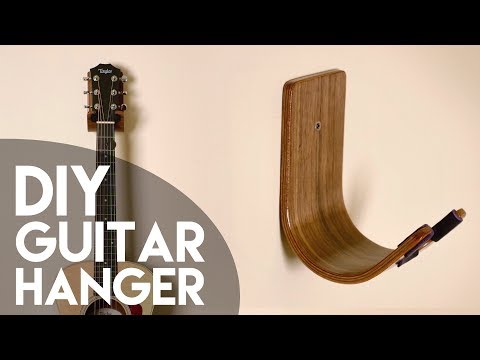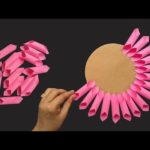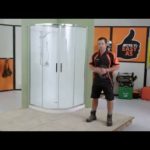
DIY Guitar Hanger // Bent Wood Lamination How To – Woodworking
I built a DIY guitar hanger using basic tools and bent wood lamination! This was my first time doing bent lamination on one of my projects and I think it turned out great. Thanks to Rockler Woodworking & Hardware for sponsoring this build, support them here: http://bit.ly/rocklercrafted
🎸 Check out the onefortythree plywood guitar hook, which was the inspiration for my guitar hanger! https://www.onefortythree.com/products/plywood-guitar-hook
► Materials Used On DIY Guitar Hanger:
Walnut Two Ply Veneer : https://amzn.to/2ICOw0u
Wood Glue : https://amzn.to/2KHzUxm
Spray Laquer : https://amzn.to/2IJ0Jkx
Leather Scraps
Barge Cement : https://amzn.to/2LlWPj7
2″ Stainless Steel Screw : https://amzn.to/2LlbxHf
► Tools Used On DIY Guitar Hanger:
Rockler Band Clamps : https://amzn.to/2IHI0da
Rockler Glue Brush : https://amzn.to/2IBrxa1
Rockler Bandy Clamps : https://amzn.to/2IC30Sg
X-Acto Knife : https://amzn.to/2KIW6Yg
Oscillating Belt Sander : https://amzn.to/2IBJhSO
Fret Saw : https://amzn.to/2s5ywgr
Rasp Set : https://amzn.to/2IYXpVD
Rotary Cutter : https://amzn.to/2kgIGrd
Countersink Bit : https://amzn.to/2IXWEfw
► SUBSCRIBE : https://goo.gl/V5gcNJ
► SUPPORT ME : https://goo.gl/pmmpTQ
► FOLLOW CRAFTED WORKSHOP!
INSTAGRAM: http://instagram.com/craftedworkshop
FACEBOOK: http://facebook.com/craftedworkshop
TWITTER: http://twitter.com/craftedworkshop
PINTEREST: http://pinterest.com/craftedworkshop
► VOICEOVER TRANSCRIPT :
The first step with any bent lamination project is to create the form. I had some small scraps of plywood that I ended up using, but any sheet good would be a great option for making a form.
I laid out the shape I was looking for, with a height of about six inches and a depth of about four inches. Keep in mind that this is the profile view of the guitar hanger.
After figuring out the shape I wanted, I cut it out using a jigsaw. I stayed right on my line when cutting, since I wouldn’t be doing any shaping until all of the pieces were together.
Next, I traced the outline of the first piece onto the remaining plywood, using it as a template. My form needed to be wider than the final width of the guitar hanger, about 3 ½”, so I needed five pieces of ¾” plywood to make up this width.
After cutting out all of my pieces, I attached the pieces together using CA glue and brad nails. I made sure to keep two of the edges flushed up, to reduce the amount of sanding I had to do later. Once all of the pieces were attached, I clamped them together and let the CA glue set up for a few minutes.
Next, I shaped the form using my oscillating belt sander. I purposely made the form just wide enough so I could sand it with this sander, as it really was the perfect tool for shaping the form. You could also clamp a regular belt sander to your workbench and get a similar result.
I started with 80 grit sandpaper to roughly flatten the form and bring all of the layers even with each other, and then switched to 120 grit to refine the curves.
With the form finished, I could move on to cutting my veneers. First, I measured the outside length of the form, taking into account the curve. I needed to make sure none of my veneer layers were longer than this measurement, since I didn’t want the ends of the pieces overhanging the form and getting damaged.
For the veneer on this build, I used this two-ply Walnut veneer from Rockler. The two plys make the veneer much more pliable and less prone to cracking, making it a lot easier to work with.
I needed to cut the veneer into strips about 3 ½” wide, and I did this with an X-Acto knife and a straight edge. The veneer cut extremely cleanly using this method, although I guess a veneer saw would have been the correct tool for the job.
I cut two strips with the veneer in this orientation, and then rotated the sheet of veneer 90 degrees and cut two more strips. These alternating grain directions make the final piece much stronger, and this is how the veneer layers in plywood are oriented.
Once I had my four strips cut, I marked in 10 ½”, slightly shorter than the outside face of the bending form, and then crosscut the strips, again using my X-Acto knife. I cut all of the strips to this length.
Before the glue up, I covered the bending form with packing tape, to make sure the veneers didn’t get glued to the form.
I also arranged the veneer layers so that the grain directions alternated, and I also made sure the inside and outside faces of the hanger would end up with the Walnut veneer facing out. The second ply on this two-ply veneer isn’t Walnut, so this is super important.
Finally, it was time for the big moment, the glue up. I used strap clamps to hold the veneers in place and then added a bunch of clamps. I’m not sure why I didn’t think about it, but creating a negative form, so that I could clamp two halves of the form together around the veneers, would have worked a lot better here, but it still ended up working out fine.









